Natural Disaster, Human Faults
(Sohu.com, Tianya.cn, Apple Daily)
The following photos were taken the Fuxin Number Two Elementary School in Fuxin town, Mianzhu city, Sichuan province. The school building was constructed in 1994. When the earthquake occurred, the buildings nearly survived but the school building collapsed and seventeen classrooms filled with students was reduced to rubble.
(United Daily News, The Wall Street Journal) At the Wufu town Number Two Elementary School in Mianzhu city, the buidling collapsed during the earthquake and three hundred students perished. Many parents of deceased schoolchidren have been holding the photos of their children and charging publicly that the school building was a 'tofu residue' project. They wanted the government to give them justice. Meanwhile, the Fuxin Number Two Elementary School in Fuxin town, Mianzhu city saw 200 lives lost when the school building collapsed.
One week after the great Sichuan earthquake, a reporter from The Wall Street Journal left Chengdu and drove north towards Wufu town. In this reporter's notes, there were occasional flower wreaths and banners with black letters on white background proclaiming: "The children did not die from a natural disaster" and "natural disasters may not avoidable, but manmade disasters are most detestable -- justice for our dead children."
The reporter then walked through the front gate of Wufu Number Two Elementary School in Wufu town. When the parents spotted a foreigner, they came over and more than one hundred of stood on both sides. The sound of the crying got louder and louder.
The reporter wrote: Ď walked towards a man wearing a safety helmet. He wore his daughter's student ID around his neck. At first, I thought that he told me with tears in his eyes that his daughter was 'almost three years old.' This made me think of my own small daughter. Then I realized that he was saying 'almost thirteen years old.' The man got down on his knees, grabbed me and cried aloud." "Suddenly all the other parents followed him and knelt down. On the whole sports field, I was the only person standing.
The man wearing the safety helmet is named Wang Zhengguo. His daughter was named Wang Xiaoyue. He said that the quality of the school building was extreme poor -- a''tofu residue' project. Other parents pointed out that there problems at the school. They were concerned that the government is hiding certain things from them.
Painfully remembering the children who suffered wrong deaths
The children did not die directly from the natural disaster; they died inside the dangerous buildings
(New York Times) Chinese Are Left to Ask Why Schools Crumbled. Jim Yardley. May 25, 2008.
The earthquake’s destruction of Xinjian Primary School was swift and complete. Hundreds of children were crushed as the floors collapsed in a deluge of falling bricks and concrete. Days later, as curiosity seekers came with video cameras and as parents came to grieve, the four-story school was no more than rubble.
Xinjian Primary School in Dujiangyan was destroyed, while a kindergarten, at left, and a hotel were barely damaged.In contrast, none of the nearby buildings were badly damaged. A separate kindergarten less than 20 feet away survived with barely a crack. An adjacent 10-story hotel stood largely undisturbed. And another local primary school, Beijie, catering to children of the elite, was in such good condition that local officials were using it as a refugee center.
“This is not a natural disaster,” said Ren Yongchang, whose 9-year-old son died inside the destroyed school. His hands were covered in plaster dust as he stood beside the rubble, shouting and weeping as he grabbed the exposed steel rebar of a broken concrete column. “This is not good steel. It doesn’t meet standards. They stole our children.”
There is no official figure on how many children died at Xinjian Primary School, nor on how many died at scores of other schools that collapsed in the powerful May 12 earthquake in Sichuan Province. But the number of student deaths seems likely to exceed 10,000, and possibly go much higher, a staggering figure that has become a simmering controversy in China as grieving parents say their children might have lived had the schools been better built.
The Chinese government has enjoyed broad public support for its handling of the earthquake, and in Sichuan on Saturday, Secretary General Ban Ki-moon of the United Nations praised the government’s response.
But as parents at different schools begin to speak out, the question of whether official negligence, and possibly corruption, contributed to the student deaths could turn public opinion. The government has launched an investigation, but censors, wary of the public mood, are trying to suppress the issue in state-run media and online.
An examination of the collapse of Xinjian Primary School offers a disturbing picture of a calamity that might have been avoided. Many parents say they were told the school was unsafe. Xinjian was poorly built when it opened its doors in 1992, they say, and never got its share of government funds for reconstruction because of its low ranking in the local education bureaucracy and the low social status of its students.
A decade ago, a detached wing of the school was torn down and rebuilt because of safety concerns. But the main building remained unimproved. Engineers and earthquake experts who examined photographs of its wreckage concluded that the structure had many failings and one critical flaw: inadequate iron reinforcing rods running up the school’s vertical columns. One expert described the unstable concrete floor panels as “time bombs.”
Xinjian also was ill-equipped for a crisis. An ambulance and other rescue vehicles that responded after the earthquake could not fit through the entrance into the school’s courtyard. A bulldozer finally dug up beneath the front gate to create enough overhead clearance. Parents say they believe several hundred of the school’s 660 pupils died.
“It is impossible to describe,” said a nurse standing on the rubble of the Xinjian site. “There is death everywhere.”
Schools are vulnerable to earthquakes, especially in developing nations where less attention is paid to building codes. The quake in Sichuan Province has already claimed 60,560 lives, and some of the flattened schools, especially those buried under landslides, could not have stood under any circumstances. The government has not provided a public list of those schools, but one early estimate concluded that more than 7,000 “schoolrooms” were destroyed.
China has national building codes intended to ensure that major structures withstand earthquakes. The government also has made upgrading or replacing substandard schools a priority as part of a broader effort to improve and expand education. Yet codes are spottily enforced. In March 2006, Sichuan Province issued a notice that local governments must inspect schools because too many remained unsafe, according to one official Web site.
Nothing is more central to the social contract in China than schools. Parents sacrifice and “eat bitter” so their children can get educations that lead to better lives. In turn, children care for their parents in old age. As in Manhattan, affluent Chinese fight to gain entrance to top schools from kindergarten onward.
But the families who sent their children to Xinjian are neither wealthy nor well connected. They are among the hundreds of millions still struggling to benefit from China’s economic rise. Many lost their jobs when a local cement plant shut down. Some sought work in more prosperous areas, leaving their children behind to attend school.
Angry parents at several destroyed schools are beginning to stage small demonstrations. On Wednesday, more than 200 Xinjian parents demonstrated at the temporary tents used by Dujiangyan’s education bureau, demanding an investigation and accusing officials of corruption and negligence.
One of the parents, Li Wei, said his son was one of 54 students who died in a class of 60 fifth graders. He said education officials told the demonstrating parents that the bureau had reported safety concerns to municipal leaders in the past. But their complaints were ignored.
“We want to bring justice for our children,” one father said the day before the protest. “We want the local officials to pay the price.”
Poor School, Long Neglected
The earthquake struck on May 12 at 2:28 in the afternoon as 20 fifth graders were rehearsing a dance on the basketball court in front of the school. Fourth graders were outside for gym class. When nearby shopkeepers rushed over, the children were standing on the court amid a cloud of dust. “They weren’t crying,” said Chen Chunmei, 35, the manager of a shopping strip beside the school. “They were in shock.”
The main building was decimated. Parents, neighbors and nearby college students arrived to find awful carnage. Ma Qiang, a decommissioned soldier living across the street, described a sickening scene.
“We were standing on the bodies of dead children, pulling out other children,” he recalled days later. He stood in the rubble and held his hand level with his head. “The concrete was this high. On the top was a boy, and two girls below him, and another boy under them, who was dead. It took four hours to dig them out.”
For hours, this ad hoc rescue team formed a line and passed along bricks or chunks of concrete in an attempt to clear debris. Bodies of children were piled on the sidewalk across the street. By late evening, paramilitary officers arrived and ordered the parents and others to withdraw outside the school gate. Many parents considered this a tardy response that was a stinging reminder of Xinjian’s low standing.
“A lot of our students came from the mountains,” said Deng Huiying, the former long-time principal. “Their parents were migrant workers.”
Xinjian is in the heart of the city of Dujiangyan. The lack of damage to the yellow-tiled kindergarten next door or to the Beijie Primary School a five-minute walk away has served as a reminder that proximity is not the same as equality.
Beijie is the city’s elite primary school, designated as a provincial-level “key” school, boasting the best facilities and the finest teachers. The kindergarten, meanwhile, was built and controlled directly by the city government of Dujiangyan. For years, Xinjian was controlled by a smaller, local township government, which had far less money and did little to improve the school.
In recent years, China’s central government has gradually abolished primary school tuition and other fees to ease burdens on farmers and migrants. Beijing has also increased its payments to local governments for education, but the main burden remains on local authorities, and many find themselves strapped for cash or siphon it off.
When Xinjian was built in 1992, many parents worked for the Dongfeng Cement Factory. Company bosses donated 40 tons of cement. But that was not enough. “Everybody knew they didn’t have enough cement,” said Dai Chuanbin, an older man familiar with the project. “So they used a lot of sand.”
Parents say the township government cut costs further by hiring farmers to do the work instead of trained construction crews. One former school official recalled that workers poured the foundation during such heavy rains that it collapsed. Another foundation had to be poured.
The school opened in 1993 and would quickly be overrun with students. The detached annex was rebuilt in 1998 after inspectors deemed it substandard. Ms. Deng, the former principal, recalled that nearby construction work in May 2006 caused the flooring in the main school building to shake violently. But she said she never had reason to believe the building was structurally unsound and never filed any written complaints with higher officials.
“If I’d thought the building was unsafe, there’s no way I would have let the kids stay there,” she said. When she saw the collapsed building, she fell on the ground, sobbing.
Several parents tell a different story. They say Ms. Deng and other school officials told them that the building was aging and unsafe, though they could provide no written proof. One father was told that Xinjian would soon be closed. Another, Zhu Junsheng, 44, claimed that Ms. Deng filed a report with Dujiangyan’s education bureau complaining about the building.
“The education bureau said there was no money,” said Mr. Zhu, sitting in front of a blue tent in a refugee camp a block from the school. “They didn’t care.
“I just want to say: The government didn’t do its job.”
Nearly two weeks after the earthquake, Mr. Ma, the decommissioned soldier, keeps returning to the rubble of Xinjian. He smokes cigarette after cigarette and has not changed out of the Che Guevara T-shirt and blue jeans he wore on that frantic afternoon.
“That’s where government officials send their children to nursery school,” he said, pointing to the undamaged, yellow-tiled kindergarten.
Mr. Ma saved several children the day of the disaster but cannot shake the memory of one girl. Her leg had been pinned beneath a heavy concrete slab. Two small cranes had failed to free her. Her body temperature was quickly dropping. So Mr. Ma told her father, “She can keep her leg or her life.”
The father was led away. Mr. Ma used a serrated knife he kept in his jeans. He said the job took three cuts across the girl’s shin. “She will hate me when she is older if she has trouble with love,” he said with a grim smile.
He does not know the girl’s name. “I have dreams every night,” he said. “She was very pretty. Very strong.”
Deadly Engineering Shortcuts
Techniques for fortifying buildings to withstand earthquakes have been clearly understood for decades. Use high-quality concrete. Embed extra iron rods. Tie them tightly into bundles with strong wire. Ensure that components of floors, walls and columns are firmly attached. Pay special attention to columns, which are the key to having a building sway rather than topple.
Engineers are already trying to assess how much of the destruction on May 12 should be attributed to faulty construction during China’s long and often helter-skelter building boom. The earthquake was so powerful, measuring at least 7.9 in magnitude, that a certain amount of damage could not be prevented. But engineering experts say Xinjian and some other schools in Sichuan were especially vulnerable.
Six structural engineers and earthquake experts asked by The New York Times to analyze an online photographic slide show of the wreckage at Xinjian concluded, independently, that inadequate steel reinforcement, or rebar, was used in the concrete columns supporting the school. They also found that the school’s precast, hollow concrete slab floors and walls did not appear to be securely joined together.
The widespread use of cheap, hollow slab floors is significant because numerous buildings with the same flooring collapsed during another Chinese earthquake in 1976, which devastated the city of Tangshan and killed at least 240,000. (A few buildings with the same flooring also fared poorly during the 1994 earthquake in California.)
“If the hollow core slabs are not adequately tied to the lateral frames, which seems to be the case in the photos, the structures are likely very flexible and would undergo large deformations under severe ground motions,” said Mary Beth Hueste, an associate professor of engineering at Texas A&M University, in an e-mail message.
When such components are not securely joined, they are “extremely dangerous, like time bombs,” said Xiao Yan, an expert in earthquake-resistant designs at the University of Southern California.
The most pronounced failing at Xinjian seemed to be inadequate steel reinforcement of the concrete columns supporting the school, experts said. There were too few rebar reinforcing rods and too little of the thin binding wire that holds the rebar together. And, critically, the steel bindings attaching the concrete flooring slabs were inadequate.
Xiaonian Duan, an engineer specializing in earthquake resilience for Arup, a multinational design consulting company whose head office is in London, said that concrete flooring panels fall apart during an earthquake if not strongly attached, “like we see Legos collapse.”
The Chinese government has known that many schools, especially in rural areas, are unsafe. Since 2001, the State Council, China’s cabinet, has budgeted roughly $1.5 billion for a nationwide program to repair dangerous schools in rural areas. In 2006, Sichuan Province’s government issued an urgent notice calling for localities to stop using substandard primary and middle schools.
“Unsafe buildings are the major hidden danger of school safety at present, and in recent years, accidents with death tolls and injuries were caused by collapsed schools,” the provincial notice warned.
Dr. Xiao toured the disaster zone after this month’s earthquake and found that many of the problems at Xinjian were common elsewhere. He said one reason for the widespread damage was that buildings in the region were not required to meet China’s most stringent standards for seismic protection. He also noted that China rates overall building design codes from 1 to 4. Buildings rated 1 are considered “important” and must meet stricter design requirements. But the system rates schools only as a 3, which means no additional design protections are needed.
In the aftermath of the quake, a handful of bricklayers and builders have visited Xinjian Primary School out of professional curiosity. A builder from nearby Meishan City recognized the faulty columns and flooring problems. Then he picked up a chunk of concrete from the rubble and rubbed it in his hands.
“The ratio of sand and concrete isn’t right,” he said. “It fell down because of cheap materials.”
In Search of Justice
The parents of Xinjian Primary School posted an online petition last Wednesday. They demanded justice for their children. Local police officials have promised an investigation, but the parents are not satisfied. They intend to protest again.
School represents hope in China. The parents do not express it exactly like that, but they saw education as their children’s only chance. The cement factory that employed many parents — and provided cement for the school — went bankrupt in 2002. They now collect small welfare payments and hold down odd jobs to support their families.
Liao Minhui had aspirations for his daughter. He knew that Xinjian was considered inferior and that a better school might help her find a better life. So he tried to wheedle her into Beijie, the elite school. He said he offered thousands of yuan to gain her admission, to no avail. She died in the Xinjian rubble.
“I tried very hard,” Mr. Liao said. “I tried to get help from every well-connected friend I have. Everything there is the best. The teachers are the best. The facilities are the best.”
Jiang Xuezheng, 41, is a small, wiry man whose simple manner betrays his country upbringing in a village about 200 miles away. He has sold fruit in Dujiangyan for nearly a decade to support his family back in the village. But to do this, he lived apart from his son for eight years.
So last year, Mr. Jiang also paid to try to win his child admission to a city school. He chose Xinjian. To him, a peasant, a city school like Xinjian represented a step up. He paid a $1,400 fee to make the switch. His 9-year-old boy was admitted in September.
“My parents are still in the countryside, but I wanted my son to live with me,” said Mr. Jiang, bowing his head and weeping. “I waited for eight years. Finally, I was together with my son.
“And then tragedy happens.”
(Washington Post) Schools Fell While Other Buildings Held. Ariana Eunjung Cha. May 23, 2008.
The day the earthquake hit was supposed to be a special one for Ding Yao. Her hair done up in pigtails, she was sitting in the front of a fourth-grade classroom, waiting for the teacher to hand out prizes to students who had the highest scores on a math test. She wasn't sure, but she was hopeful she would get one.
One floor above her, fifth-graders Sang Xingpeng, the class troublemaker, and Peng Xinyin, the tall girl who loved to sing, were enjoying their midday break.
Outside, third-grader Zhou Yang was running late, busy playing with friends and chasing bees.
This, according to teachers, parents and students interviewed, was the scene at Fuxin No. 2 Primary School a few minutes before 2:28 p.m. on May 12 -- when a massive earthquake ripped through China's Sichuan province in the country's worst natural disaster in 30 years. By the end of the day, 127 of the school's 320 students would die, buried in a mess of concrete chunks and flying glass.
Since the quake, parents' grief has turned to anger.
Why, they ask, did the school collapse when other nearby buildings, including government offices, the teachers' dormitory and even an old classroom building housing pet rabbits, withstood the quake?
The same question is being asked all over Sichuan, as residents have started to notice that, on street after street, schools collapsed while most government buildings did not. In Mianzhu county, a quarter of the 43 primary and secondary schools caved in, leaving more than 1,000 students dead, while the gleaming government complex remained fully operational and is now a staging area for emergency rescue and cleanup operations.
In total, nearly 7,000 schools have been reported destroyed in Sichuan by the quake; that figure could rise as reconstruction crews reach the hardest-hit areas.
China's leaders have launched an investigation into why so many schools collapsed. Jiang Weixin, the minister of housing and urban-rural construction, said this week that authorities "cannot rule out the possibility that there may have been shoddy work and inferior materials during the construction" of some school buildings.
On Thursday, Mianzhu county announced that it would form a special committee to investigate the construction of the school in Fuxin. The principal, Wang Weiyong, asked parents to be patient and wait for experts to assess what happened here. But Liu Bo, a deputy director of the Mianzhu Education Bureau, said in an interview that he had already gone through the documentation regarding the school's annual inspections and that he believed it was perfectly safe.
"What happened isn't the result of a dangerous building," Liu said. "This tragedy is the result of a natural disaster."
Parents who have lost their children say the truth is in the rubble.
Zhang Longfu, 39, whose 12-year-old daughter, Zhang Ju, died at the school, said there is no evidence that the building ever had a solid frame. In the ruins, other than the concrete, there are only tiles and a few pieces of twisted metal cables.
"This building is totally a 'bad tofu' project," Zhang Longfu said, using the term in China for cheap, shoddy construction work. "Look at it -- it's not properly done. We feel it is wrong for kids to die this way."
The Nightmare Begins
On May 12, the first sign of the nightmare to come was the dust.
At 2:28 p.m., Zhou Yang was in front of the school playing with friends when the ground shook. Dust started to emanate from the building. "I thought, 'I just had a shower. I don't want to get dirty.' So I stayed outside," Yang later recalled.
Then the screaming began. The windows blew out. Pieces of the building started falling off.
The quake occurred at just about the worst time for the students. Their midday break was ending, but class hadn't yet started. That meant nearly all of the students were in the building, but few of the school's 32 teachers were there to offer direction.
Students in Yang's third-grade class were lucky. Because they were on the first floor, they quickly stampeded out through four exits.
In the fourth-grade classroom next door, teacher Li Mingqing was yelling: "It's an earthquake! Run, children, run!" Li recalled seeing Ding Yao, the girl with pigtails, moving slowly. She scooped her up, tucked the girl's head down and ran for safety.
Li's classroom had been packed with 75 students for the awards ceremony. But one of the doors was locked. The students struggled to get through the remaining door. Only 36 made it out.
Students in the fifth- and sixth-grade classes upstairs also started fleeing. But only so many who could fit on the stairs at one time. A few tried to take the bridge to the teachers' building but then changed their minds and turned around. They had been told that they would be punished if they ever took that route.
Peng Xinyin and Sang Xingpeng were next to each other, somewhere in the middle of the crowd.
Li, the teacher, had barely cleared the building when it collapsed. "I turned around and looked and thought, 'What now? What now?' " she recalled.
Xinyin's mother, Zhang Xuemei, was the first parent to reach the school. She recalled spotting her daughter's teacher and three others standing in front of the debris.
"Are all the students out?" she called out.
The teacher answered: "Only a few. Maybe five or six."
"My daughter?"
Pause. "She's still in there."
Zhang fainted, then woke up to chaos. Parents were crying and calling out their children's names, digging through concrete chunks with bare hands. Many were bleeding from cuts. Some teachers -- only two of them had been in the building when it fell -- joined in the search.
Just after 3 p.m., one hysterical mother located her 10-year-old daughter and pulled her out. She splashed water over her face. The girl was already dead.
For one family, a whole generation was wiped out. A sister and her two brothers each discovered they had lost a child.
Rescue workers found Xinyin just after 7 p.m. She was at the bottom of the stairs, about a yard from safety when the building caved in. There was so much debris that it took until 2:30 a.m. to free her. She had died instantly when a stone or other debris struck her neck, a doctor told the family. Sang Xingpeng was a few steps behind her, one of his legs in front of the other as if he was still running. He had suffocated to death.
A Town Divided
Nearly two decades ago, Xingpeng's mother, Liu Ying, was among the first to attend Fuxin.
Now 34, Liu said she remembers that soon after she and other students started at the school, the third floor started to develop cracks.
"I couldn't imagine that after so many years they wouldn't have fixed the problems and our kids would be dead in here," Liu said.
In the days since the quake, Fuxin has become a town divided.
Those who lost a child -- their only, because of China's one-child policy -- have bonded together and kept a constant vigil at the school.
Those whose children survived have avoided the school and, in some cases, have decided it is best to act as though nothing ever happened.
On Tuesday, for instance, while Liu was on her way back home from visiting the spot where her son, Xingpeng, has been buried, a neighbor whose daughter survived told her she had heard the semester's exams would be postponed as a result of the quake. Did Liu know anything about that?
Liu politely shook her head and continued home, where she finds comfort in her son's things.
There are the goldfish and turtles her husband gave Xingpeng a few days before the quake. There's the loquat tree that he had been so eager to eat from that he counted the pieces of fruit each day. And then there are the best things, Liu said, the signs of his mischief: the stickers of pop stars on the walls, the broken decorations, the ruined potatoes he pulled out from the ground before they were ready to be eaten.
(Los Angeles Times) Anger builds in China over collapsed schools. By Mark Magnier and Don Lee. May 24, 2008.
The No. 2 Elementary School was the only building in the area that collapsed, killing perhaps as many as 129 children.
Nearby, a mud-and-brick house villagers said was built during the 1644-to-1911 Qing Dynasty remained intact. A three-story concrete and steel police building showed little damage, except for a few broken windows."Come over here. Look at this. That's a main beam," said Zhang Daolin, 37, a farmer whose son Zhang Wei, 12, died in the school collapse. "There's no steel inside. This was a three-story building. How could you hold it up?"
Like Zhang Daolin, grieving parents have repeatedly questioned the quality of school construction after the magnitude 7.9 earthquake that struck Sichuan province May 12. So many primary students died in the town of Yingxiu that residents have talked about losing a generation.
Officials have not released the number of students killed, saying only that nearly 7,000 schoolrooms were destroyed. Last week, amid angry questions from the public, officials of the Construction and Education ministries announced an investigation into why so many schools had collapsed.
Parental rage at the weak construction of schools could become a major challenge for the government. These are not political dissidents or "troublemakers" the Communist Party can easily write off, but parents who have lost children at a time of more civil or "people- oriented" policies by the administration of President Hu Jintao.
Increasingly, sorrow has intensified the anger at the government.
At the pile of rubble that had been Fuxin No. 2 Elementary School, 150 parents, uncles and grandmothers Thursday sat in long rows clutching framed pictures of their dead children.
A long banner had children's names written in their parents' blood. Another banner directed at local and Communist Party officials read, "Leaders, you're safe, you can sleep comfortably. How about those poor children?"
At the far end of the rectangular courtyard that was once the school driveway, they had built a makeshift shrine. A tape recorder played Buddhist chants in a loop. Incense sticks bristled from three plastic dishpans beside burning red candles and more pictures of dead students placed on top of student desks.
Parents said the three-story school building, normally used by more than 300 students, had only one open door. Many students, they said, died in the crush to flee after a single, narrow stairway collapsed on them.
All 20 teachers, most of whom were in the still-intact teachers building when the quake hit, survived, several parents said. They alleged that the few teachers who were in the school raced ahead of children to get out first, with the exception of one teacher who rescued several students.
As with some of the other schools that have completely or partially collapsed in the quake-hit area, which is about the size of Connecticut, the teachers quarters and a meeting room area around the classrooms remained largely intact.
Parents said local officials had avoided them. They said officials claimed that only 50 students died. No local media had come to report the story, they believed, because of local governmental pressure to cover up misdeeds.
"I plan to come here every day until those who approved this construction are punished," said Chen Xuefen, 32, as she cradled a picture of her 11-year-old son, Jing Chung.
Even worse than the structural issues, some parents said, was the role authorities played. Parents said students were transferred to this school in September so that the building they previously used could be leased to an apparel factory. They suspect that officials have pocketed the proceeds. That building wasn't damaged.
Zhu Qi, vice bureau chief of the Mianzhu Education Administration, said building safety was not his agency's responsibility and that he didn't have expertise in steel reinforcement or exits, the purview of the construction bureau.
But he said a task force had been formed to investigate the collapse of the school, which was built in 1988 at a cost of $28,000.
Zhu said the administration was also investigating whether teachers had fled, but he said the earthquake occurred during a break, so that might explain why more teachers weren't in the school. Local officials have met with parents, he said, and haven't tried to control the media. He said he had no knowledge of the former school being leased to a private company.
For parents such as Song Min, who sat outside the school holding a picture of her smiling 11-year-old son, Feng Junwei, the main goal was not to blame the central government or the education administration for the tragic losses, but rather to try to push for safer buildings.
"We hope there will be real change in the way schools are built so children can study peacefully," Song said.
"We just hope such a tragedy doesn't happen to anyone else."
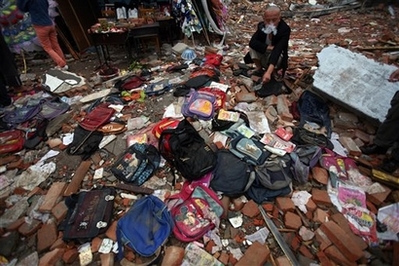
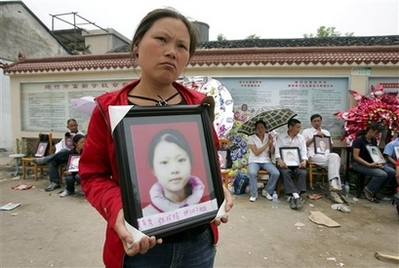
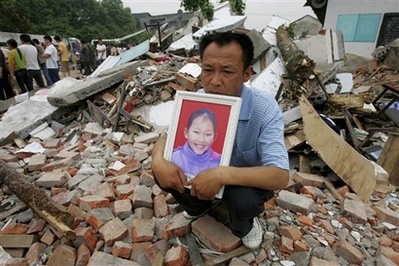
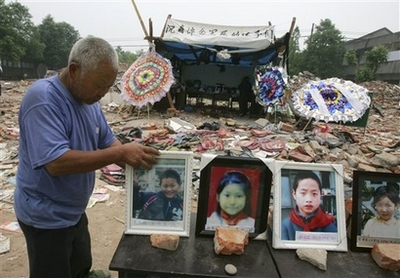
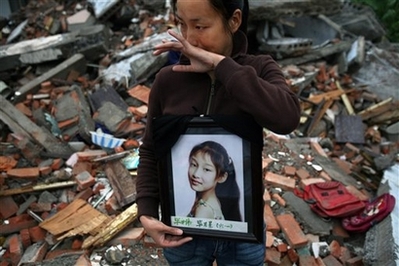
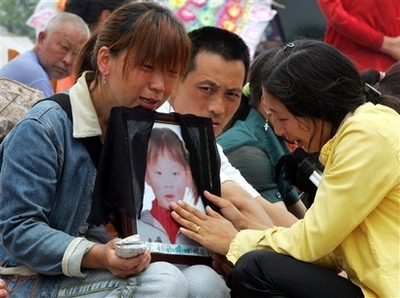
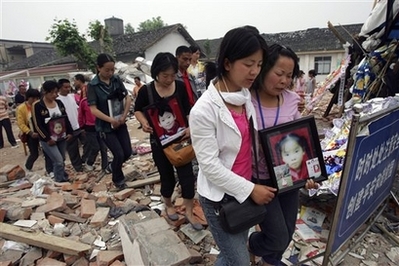
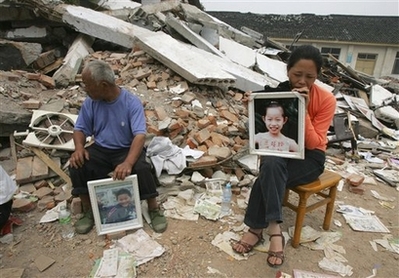
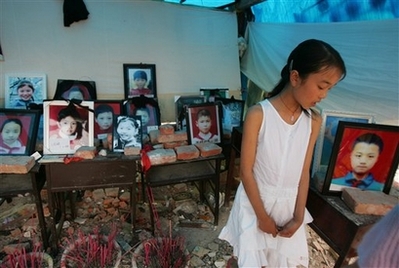
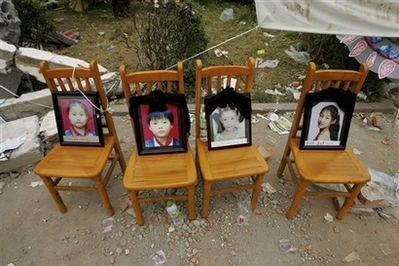
Related Link: Why Did the Building Collapse?